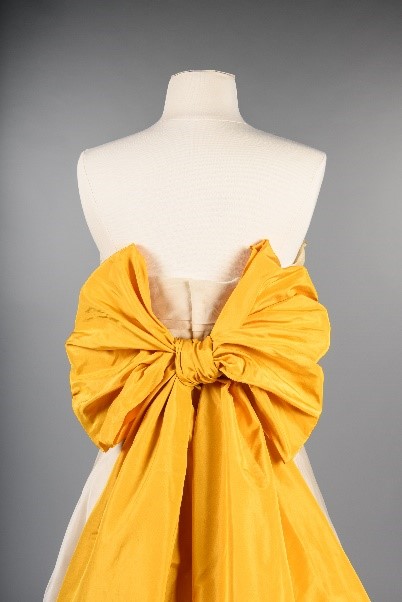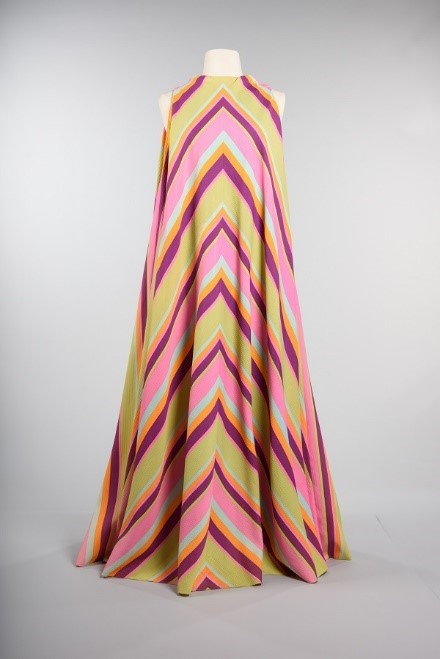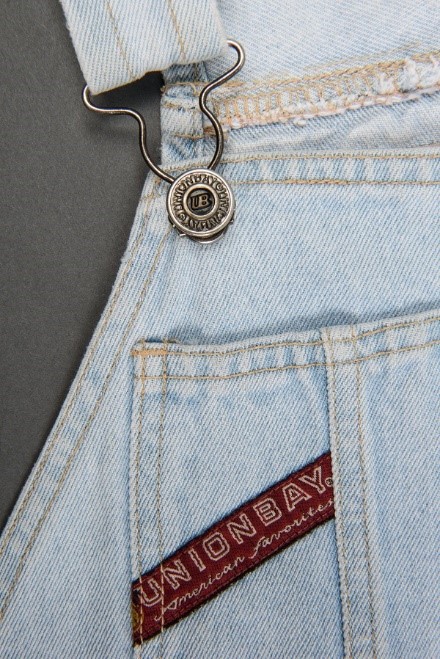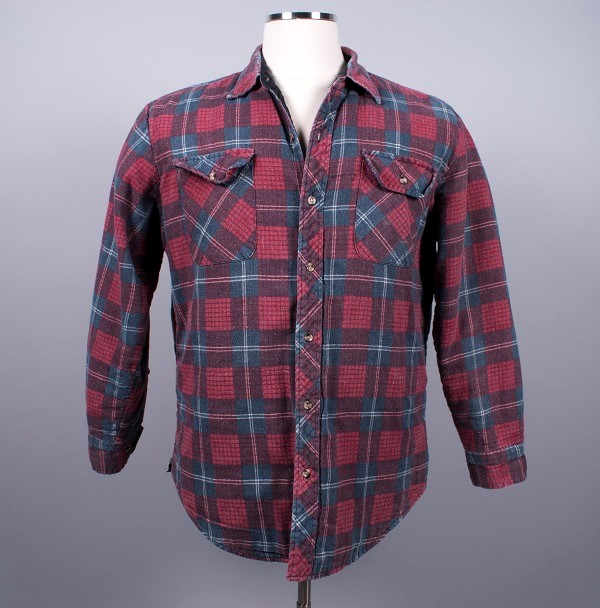FOR IMMEDIATE RELEASE
February 6, 2019
Contact: Wendy Malloy
Museum of History & Industry PR
wendy.malloy@mohai.org
206 324 1126 Ext. 150
Seattle’s Museum of History & Industry (MOHAI) Presents Seattle Style: Fashion/Function
February 6, 2019
Exceptional examination of Seattle fashion ranging from couture, to outdoor gear, to denim on view May 4-October 14, 2019

SEATTLE, WA – This spring Seattle’s Museum of History & Industry (MOHAI) presents Seattle Style: Fashion/Function, featuring garments and accessories from the museum’s collection and revealing captivating stories about the city’s sartorial spirit.
Presented by Nordstrom, this exciting exhibit, on view at MOHAI May 4-October 14, 2019, highlights how elegance and practicality co-existed and converged in Seattle wardrobes, providing new insights into local clothing, ranging from couture to grunge aesthetics to outdoor gear. Alone, few of these ingredients are unique to Seattle. But, woven together, a distinct local story emerges. No single style defines this region. Instead, when we look at the clothing made and worn here, enduring themes emerge: influences of the weather, ambition, a casual nature, and a spirit of people forging a new path.
“I am delighted the Museum of History & Industry is presenting this stunning collection as we share a fascinating and influential period in Seattle fashion history.” said Leonard Garfield, MOHAI’s Executive Director.
Curated by Clara Berg, MOHAI’s Collections Specialist for Costumes and Textiles, the exhibit explores the sensibility of Seattle fashion and its sense of beauty embodied in clothing. Bringing together rarely seen garments and accessories from the mid-1800s to today, the exhibit also includes three “Sewn in Seattle” videos and historical fashion show footage.
“Seattle has a rich history of clothing makers and style leaders,” said Berg. “Outdoor gear, casualwear, grunge—are connected to key parts of our history and had a national and international impact. There are many stories of high fashion here as well—people who wore it, stores that imported it, and designers who made it. My hope is that after visiting the exhibit our guests walk away thinking “Wow! I had no idea!”
The exhibit is structured in a combination of thematic sections:


The first thematic section, Nature and Place, explores the influence of the natural surroundings. Dressing for the environment is a way of life in Seattle. Rain falls 150 days a year on average, and outdoor adventure always feels steps away. Water surrounds Seattle on the east and west. Snowcapped mountains are within sight of downtown, and green spaces can be found throughout the city. Here, people balance a city lifestyle with an outdoor one.
Seattle’s clothing—items made or worn here—demonstrates the influence of the natural surroundings. From the hardiest of gear to an elegant evening coat, materials and designs show a combination of functional and stylish elements.
Seattle’s passion for blending weather-tested pieces with visual impact continues with traditional materials, as well as new ones like waxed cotton, Gore-Tex, and vinyl.
The Gore-Tex jacket pictured above manufactured by Seattle-based company Mountain Safety Research (MSR) was one of the first to use Gore-Tex for recreational wear. Originally worn strictly for outdoor adventures, expensive high-tech gear like this jacket has found its way into daily city wear, becoming a Seattle status symbol.
The ensemble on the right was made by the Seattle Woolen Company, which began with a focus on menswear and water-repellant garments to appeal to “woodsmen, cannery workers, and fishermen.” They soon expanded to include clothing for sport and recreation and began making more options for women. As it became increasingly acceptable for women to participate in sporting activities, local companies met the demand. In the 1940s, Seattle Woolen Company began advertising their line of “Terrain Tested Ski Clothing from Ski Country” for both men and women.


The second section is Growth and Aspiration. When Seattle was a frontier town—little more than wood structures and muddy streets—pioneer residents imagined its future as a sophisticated, global city. The first name for the settlement was even “New York Alki,” alki meaning “by and by” or “in the future” in the local trade language of Chinook Jargon. Becoming a city has meant times of rapid growth and huge change—the two seem to have become part of Seattle’s DNA.
Since its earliest days, Seattle has had a connection to fashion. As it started to grow into a bustling city, some Seattleites looked to fashion—the presence of and access to it—as a measure of cosmopolitan success. Especially in the first half of the 20th century, it was commonly understood that the most fashionable items came from afar. The 1937 peach gown pictured above was worn by Seattle socialite Guendolen Carkeek Plestcheeff and designed by couture designer Elsa Schiaparelli, with a studio in Paris. Plestcheeff made buying trips to stock her wardrobe and was frequently cited as one of the city’s best dressed.
Thanks in part to giants like Microsoft and Amazon, the 21st-century tech boom is pushing Seattle’s population to new limits. This kind of growth shapes the population and its needs, which in turn influence local stores and companies by drawing a population of talent, including programmer Fabienne Serrière. Serrière first experimented with knitting by hacking small consumer knitting machines. She launched Seattle company, KnitYak, which combines industrial knitting with inventive computer programming. Most beginner programmers learn the elementary cellular automata code, yet it outputs seemingly complex visual structures—as seen in this scarf pictured above. Each stitch acts like a screen pixel: black and white stitches represent binary 0s and 1s.


In the next section, Northwest Casual is considered. It is no secret that when it comes to style, Seattle leans casual. It started in the days when harsh frontier life led to loosened norms and has endured as a hallmark of a West Coast style of living. After the late 1960s, the idea that fashion is an indication of success started to fade and for some, fashion was frivolous. A local preference for the informal paved the way for Seattle’s casualwear industry to thrive in the late 20th century. The city’s industry has seen ups and downs, but a love of casual holds steady.
The definition of what clothes are considered acceptable for day-to-day wear changes over time. Like elsewhere on the West Coast, Seattle has been at the forefront of an increasingly casual style of American dress.
The hostess gown, seen above left, was a style popular from the 1930s through 1970s. Designed to be both casual and formal, the hostess gown acted as a sort of hybrid of an evening gown and lounging pajamas. Women would wear them when acting as party hostess in their own homes. Popular from the 1930s through the 1970s, hostess gowns needed to be both formal and relaxed—between an evening gown and lounging pajamas. They are often loose-fitting and brightly patterned.
As the demand for informal clothes grew in the mid-century, a distinct network of Seattle garment factories grew too. And later in the century, it was Seattle’s turn to export some of the hottest trends of the day. Local brands boomed. But this later wave of companies made clothes exclusively overseas. Today, companies remain, though the presence of garment factories has noticeably faded. A good example is this image of a UNIONBAY Shortall piece. Named after Seattle’s Union Bay on Lake Washington, UNIONBAY was part of a wave of casualwear companies that sprung up and thrived in the 1980s. It is now one of the city’s longest-running jeans and casualwear companies.
Designs originally for sports or at-home wear have gradually become acceptable for other occasions. As MOHAI’s collection shows, materials and cuts reflect intended use, but style is never forgotten.


The final section focuses on Innovators and Rule Breakers. Throughout Seattle’s clothing history, people have recognized needs and created solutions for themselves and others. Some solutions have been inspired by technical needs, others by an artistic vision that counters the city’s casual norms, and others by a creator’s beliefs or identities. After all, what people wear can be key to their self-expression.
These garments combine all of Seattle’s enduring clothing influences—natural surroundings, aspiration for something greater, and affinity for the informal—together with an innovative and rule-breaking spirit. In every case, they contribute to the variety and diversity found in Seattle’s styles. This section includes designers with a glamorous vision that defies Seattle’s informal attitude with gowns from Luly Yang, Mark Mitchell, and Howard Blair.
The exquisite 1959 gold gown and coat pictured above are made with over 50 yards of silk. Howard Blair designed for those who wanted to stand out. He created wedding gowns, evening attire, and pageant queen dresses. To ensure this ensemble grabbed attention—as if the obvious details would not—Blair attached small bells under the skirt.
Sometimes, groups or individuals have a belief or identity not represented in mainstream clothing styles and so create something that does. The resulting garments reveal and celebrate the creativity, ingenuity, and diversity of the individuals who make up the region.
There is no fashion moment more associated with Seattle than grunge. The plaid shirt pictured above left is a mainstay of the grunge style that emerged with the local alternative-rock subculture that started in the late 1980s and exploded nationally in the early 1990s. The look had ingredients of punk style, local workwear, gender-flexibility, and chilly weather practicality, all rolled together with an anti-establishment attitude. Thrift stores were the go-to place for the grunge look.
Thrift shopping saved money, but it was also a way to reject flashy 1980s mainstream fashion. Plaid flannels—the workwear of Pacific Northwest timber workers—and worn jeans were plentiful. To keep warm, long johns were added as a visible layer. Initially the style of losers and misfits, the grunge look ended up becoming the height of cool.
From outdoor adventurers keenly aware that the right clothing can be a lifeline to fashion devotees going great lengths to bring chic treasures back home, to those who want to change narratives around what we wear, Seattleites care deeply about fashion. Grunge may be the style most associated with Seattle, but its ingredients—utilitarian needs, casual dressing, and a nonconformist attitude—resonate in many Seattle clothing stories before and since.
Seattle Style: Fashion/Function exhibit is organized by Seattle’s Museum of History & Industry (MOHAI) and presented by Nordstrom. The exhibit is accompanied by a companion book, Seattle Style: Fashion/Function. Edited by Berg, with a forward by internationally known Seattle-based fashion designer Luly Yang, Seattle Style unveils the complex narrative of Seattle’s vibrant clothing scene.
Additional generous support for Seattle Style: Fashion/Function has been provided by Laird Norton Wealth Management, Mike Repass, Eddie Bauer, ArtsFund and the Guendolen Carkeek Plestcheeff Endowment for the Decorative and Design Arts, 4Culture, and the MOHAI Exhibits Fund.
UPCOMING PROGRAMS AND EVENTS RELATED TO THE SEATTLE STYLE: FASHION/FUNCTION EXHIBIT
(Details are subject to change, and additional programs and events may be added).
Seattle Style: Fashion/Function Opening Day
Saturday, May 4
10 am – 5 pm
Included with admission
Celebrate the opening of Seattle Style: Fashion/Function exhibit on this family-friendly day. Enjoy performances, craft activities, story time and much more! Please check the website soon for updated details.
Ethical Fashion: Rethinking the Future of an Industry
Wednesday, May 8, 7 pm
$5 MOHAI Members/$10 General Public
Much of the available today is made unethically, worn briefly, and discarded in a landfill when trends change. How can we create fashionable clothing in a more ethical way while designing and developing eco-friendly, sustainable products? Join us for a panel conversation moderated by Sydney Mintle of Gossip & Glamour, featuring local innovators who are redesigning the future of fashion production.
Behind the Seams: High Fashion Favorites
Saturday, May 11, 11 am, noon, and 2 pm
$10 MOHAI Members/$15 Students/$25 General Public
The special exhibit Seattle Style: Fashion/Function features a small sample of glamourous garments from MOHAI’s collection. Here’s an opportunity to join exhibit curator Clara Berg for a sneak peek of her favorite hidden garments from MOHAI’s vault. Perfect for the mother in your life this Mother’s Day weekend!
MOHAI Mother’s Day Pop-Up Shop
Saturday, May 11, 11 am – 3 pm
Free (gallery admission not included)
Drop by the brand new MOHAI Mercantile (formerly the MOHAI Store) for a special Mother’s Day inspired pop-up shop featuring a variety of unique gifts and goods from local artists and designers. Enjoy mimosas and other treats while you shop. Special pricing on merchandise and mimosas for MOHAI Members!
INTRINSIC: Student Designer Fashion Show
Friday, May 17, 7 pm
$10 MOHAI Members & Students/$20 General Public
View the future of Seattle fashion in this interactive fashion presentation, featuring Seattle Pacific University’s MODE Fashion Group. Student designers and stylists present collections shaped by Seattle history, developed in conversation with local fashion businesses and responding to the challenge of designing for a broadly inclusive audience. Meet the designers, view their collections, and learn about their design journeys.
(Re)Fashion: Clothing Repair Fair
Saturday, June 1, 11 am – 2 pm
Workshop 11 am & 2 pm
Drop in demonstration Free for MOHAI Members (included with admission)
Workshop $15 MOHAI Members/$30 General Public
Refuse fast fashion and reclaim your clothes. Learn how to mend, restore, and clean cherished articles from your wardrobe. Drop-in to a mending demonstration, or purchase tickets to a hands-on repair workshop. Bring your old favorites to restore and learn from our region’s top clothing saviors.
Behind the Seams: Fashioning the Ideal Body
Saturday, June 22
11:00 am; 12:00 pm; 2:00 pm
$10 MOHAI Members/$15 Students/$25 General Public (Museum admission included)
In every era, fashionable clothing is designed with an ideal body in mind. Join Seattle Style: Fashion/Function curator Clara Berg for a look at how these ever-shifting ideals were built into garments to shape the body and fool the eye. These intimate one-hour sessions allow viewers to discover garments in detail and hear the stories that make them special.
Cocktails & Clothing: Designing Sustainable Fashion
Wednesday, June 26, 7 pm
$30 Members/$50 General Public (21+ Over) Free cocktail included with ticket.
For one night, MOHAI hosts local designers leading the new wave of sustainable fashion in this interactive evening of cocktails and creativity. Witness the unique design process of Janelle Abbott and try your hand at fun and funky upcycling with Malia Peoples. Discover a range of sustainable garments at pop-up shops by Zakiya Cita of The Chayah Movement and Prairie Underground.
September 1-30
September is Seattle Style Month! Celebrate MOHAI’s featured exhibit Seattle Style: Fashion/Function with a month-long, city-wide salute to Seattle’s passion for fashion and culture. Unique fashion-inspired events and programs will take place across the city!
Location, Hours, and Admission
MOHAI is located at 860 Terry Ave. in Seattle. Exhibit gallery hours are 10 a.m. to 5 p.m. daily. Admission is free on first Thursdays to MOHAI’s regular galleries and open until 8 p.m. As part of the Museums For All program, low-income families can visit MOHAI for a minimal fee of $2 per person with the presentation of an Electronic Benefits Transfer (EBT) card. For more information, call (206) 324-1126.
Image Captions: Evening gown with taffeta bow, Irene, Los Angeles, maker. Frederick & Nelson, retailer, about 1955. © MOHAI Collection, Gift of Mrs. C. Winkler. Early Gore-Tex hooded rain jacket, Mountain Safety Research (MSR), Seattle, maker, about 1976. © MOHAI Collection, Gift of Mary Ann Dobratz. Wool ski ensemble, Seattle Woolen Company, Seattle, maker, about 1948. © MOHAI Collection. Gift of Frances Seeley (Byron L.) Nevilier. Silk evening gown, Schiaparelli, Paris, maker. Guendolen Carkeek Plestcheeff, owner, 1937 © MOHAI Collection. Gift of Mrs. Theodore (Guendolen) Plestcheeff. Cellular automata knit scarf, KnitYak, Seattle, maker, 2018. © MOHAI Collection, Gift of KnitYak. Hostess gown, John Doyle Bishop, retailer. Marilyn Domoto Webb, owner, 1971. ©MOHAI Collection, Gift of Marilyn Domoto Webb. Denim Shortall, UNIONBAY, Seattle, maker, 1994. © MOHAI Collection. Gift of UNIONBAY (Seattle Pacific Industries). Evening gown and coat, Howard Blair, Seattle, maker, 1959. © MOHAI Collection, Gift of Howard Blair.
About MOHAI
MOHAI is dedicated to enriching lives through preserving, sharing, and teaching the diverse history of Seattle, the Puget Sound region, and the nation. As the largest private heritage organization in the State of Washington; the museum engages communities through interactive exhibits, online resources, and award-winning public and youth education programs. For more information about MOHAI, please visit mohai.org, or call (206) 324-1126. Facebook: facebook.com/seattlehistory Twitter: @MOHAI.